Optical Properties of Two Complementary Samples of Intermediate Seyfert Galaxies
Abstract
1. Introduction and Motivation
2. Sample Selection
3. Spectral Analysis
3.1. Preliminary Steps
3.2. Line Fitting
3.3. Notes on the Sample
4. BPT/VO Diagrams
5. Line Ratios
5.1. Seyfert Type versus Balmer Decrement
5.2. Seyfert Type versus [O III]/H
5.3. L versus [O III]/H
6. Conclusions and Future Work
Author Contributions
Funding
Data Availability Statement
Acknowledgments
Conflicts of Interest
Appendix A
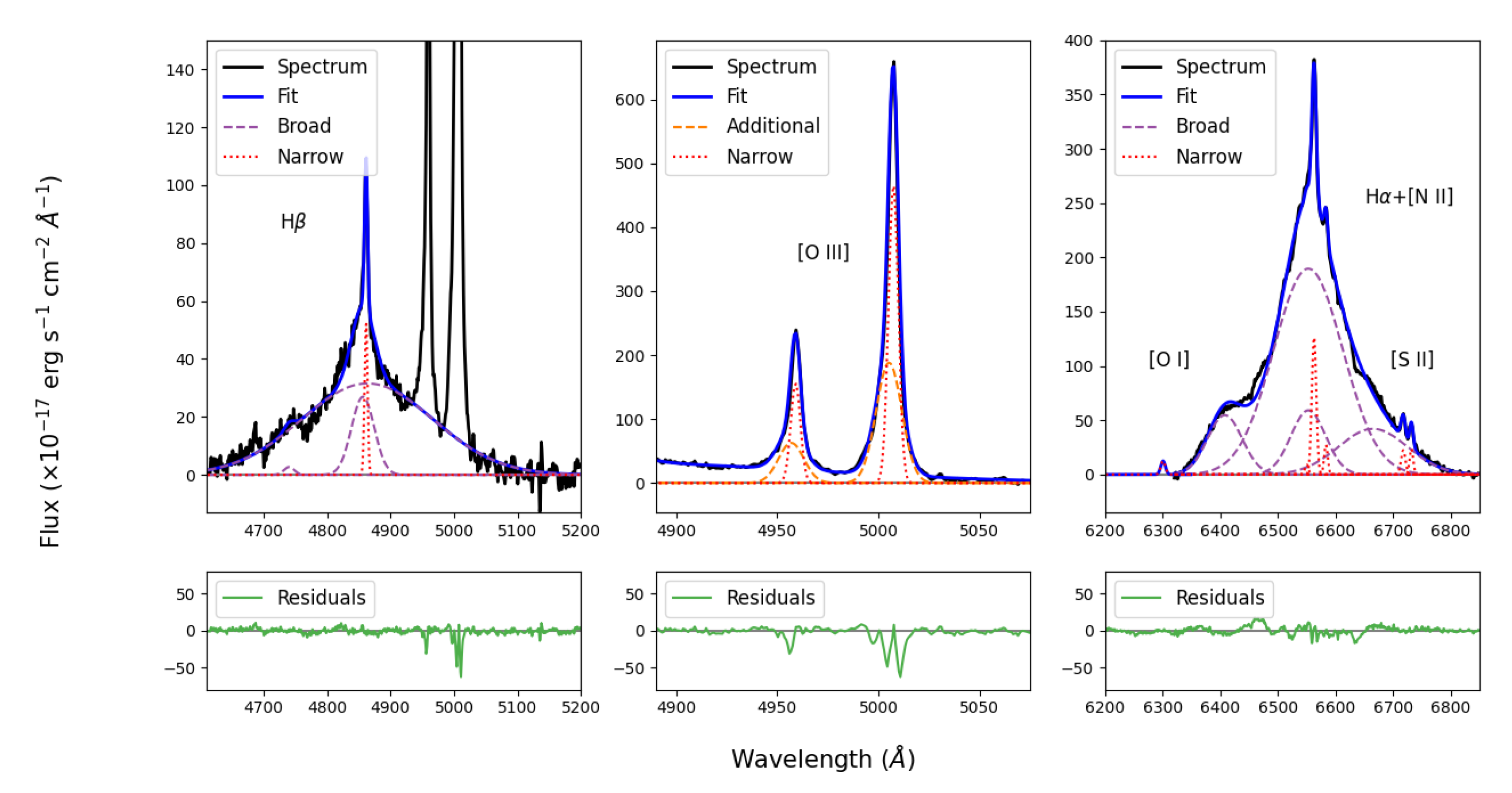
Appendix B
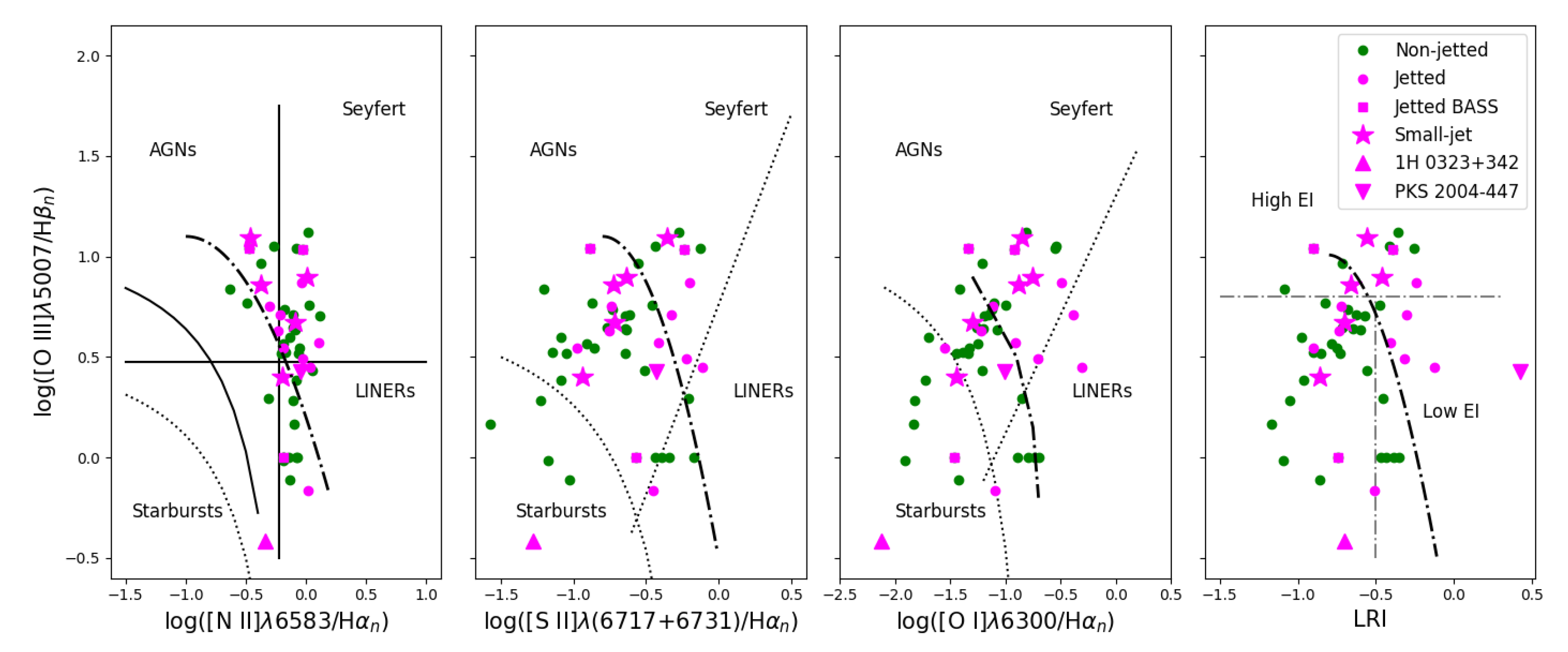
| 4FGL | BASS | |||
|---|---|---|---|---|
| Axis | Shift | Shift | ||
| log([N II]/H) | 0.52 | 0.32 | 0.08 | 0.10 |
| log([S II]/H) | 0.43 | 0.22 | 0.11 | 0.18 |
| log([O I]/H) | 0.43 | 0.31 | 0.15 | 0.21 |
| log([O III]/H) | 0.63 | 0.32 | 0.19 | 0.57 |
Appendix C
| IAU Name | Alias | RA | DEC | z | Telescope | Exposure | Date | |
|---|---|---|---|---|---|---|---|---|
| (° J2000) | (° J200) | () | ( cm) | (ks) | ||||
| BASS | ||||||||
| J0149-5015 | 2MASX J01492228-5015073 | 27.34 | −50.25 | 2.99 | 1.75 | Palermo | 1.20 | 2010-11-12 |
| J0157+4715 | 2MASX J01571097+4715588 | 29.30 | 47.27 | 4.79 | 11.0 | Perkins | 2.40 | 2011-05-01 |
| J0206-0017 | Mrk 1018 | 31.57 | −0.29 | 4.27 | 2.48 | SDSS | 2.70 | 2000-09-25 |
| J0214-0046 | Mrk 590 | 33.64 | −767.00 | 2.63 | 2.77 | SDSS | 4.20 | 2003-01-10 |
| J0234-0847 | NGC 985 | 38.66 | −8.79 | 4.30 | 3.48 | Palomar | 0.15 | 2013-08-13 |
| J0238-4038 | 2MASX J02384897-4038377 | 39.70 | −40.64 | 6.13 | 2.06 | Palomar | 0.15 | 2013-08-13 |
| J0312+5029 | 2MASX J03120291+5029147 | 48.01 | 50.49 | 6.15 | 3.45 | Perkins | 2.40 | 2011-06-01 |
| J0330+0538 | 2MASX J03305218+0538253 | 52.72 | 5.64 | 4.58 | 1.16 | UH | 1.22 | 2012-11-01 |
| J0333+3718 | 2MASX J03331873+3718107 | 53.33 | 37.30 | 5.47 | 1.48 | Masetti | 1.80 | 2006-10-02 |
| J0423+0408 | 2MASX J04234080+0408017 | 65.92 | 4.13 | 4.62 | 12.6 | Palomar | 0.15 | 2012-10-18 |
| J0503+2300 | LEDA 097068 | 75.74 | 23.00 | 5.81 | 23.4 | Palermo | 1.80 | 2009-01-29 |
| J0605-2754 | 2MASX J06054896-2754398 | 91.45 | −27.91 | 8.98 | 2.64 | Masetti | 1.00 | 2009-11-30 |
| J0733+4555 | 1RXS J073308.7+455511 | 113.29 | 45.92 | 14.15 | 7.19 | SDSS | 3.30 | 2004-11-05 |
| J0736+5846 | Mrk 9 | 114.24 | 58.77 | 3.99 | 4.83 | Palomar | 0.15 | 2014-02-22 |
| J0742+4948 | Mrk 79 | 115.64 | 49.81 | 2.21 | 5.43 | FAST | 0.72 | 2005-12-29 |
| J0752+1935 | 2MASX J07521780+1935423 | 118.07 | 19.60 | 11.70 | 4.06 | SDSS | 3.30 | 2003-10-27 |
| J0803+0841 | 2MASX J08032736+0841523 | 120.86 | 8.70 | 4.68 | 2.87 | SDSS | 4.50 | 2007-02-08 |
| J0804+0506 | Mrk 1210 | 121.02 | 5.11 | 1.35 | 3.86 | Palomar | 0.15 | 2012-10-18 |
| J0829+4154 | 2MASX J08294266+4154366 | 127.43 | 41.91 | 12.61 | 3.57 | SDSS | 3.50 | 2008-02-28 |
| J0832+3707 | FBQS J083225.3+370736 | 128.11 | 37.13 | 9.20 | 3.27 | SDSS | 5.10 | 2002-01-23 |
| J0840+2949 | 4C +29.30 | 130.01 | 29.82 | 6.47 | 4.56 | SDSS | 22.89 | 2003-10-25 |
| J0842+0759 | 2MASX J08420557+0759253 | 130.52 | 7.99 | 13.37 | 5.76 | SDSS | 2.24 | 2003-11-21 |
| J0843+3549 | 2MASX J08434495+3549421 | 130.94 | 35.83 | 5.39 | 2.98 | SDSS | 2.10 | 2003-02-02 |
| J0904+5536 | 2MASX J09043699+5536025 | 136.15 | 55.60 | 3.72 | 2.32 | SDSS | 9.00 | 2000-12-29 |
| J0918+1619 | Mrk 704 | 139.61 | 16.31 | 2.95 | 2.74 | Palomar | 0.15 | 2015-02-17 |
| J0923+2255 | MCG +04-22-042 | 140.93 | 22.91 | 3.30 | 3.60 | Palomar | 0.15 | 2015-02-17 |
| J0925+5219 | Mrk 110 | 141.30 | 52.29 | 3.52 | 1.27 | SDSS | 4.80 | 2006-01-05 |
| J0926+1245 | Mrk 705 | 141.51 | 12.73 | 2.86 | 3.43 | SDSS | 5.10 | 2006-12-23 |
| J0935+2617 | 2MASX J09352707+2617093 | 143.86 | 26.29 | 12.21 | 1.56 | SDSS | 13.02 | 2005-12-28 |
| J0942+2341 | CGCG 122-055 | 145.52 | 23.69 | 2.13 | 2.42 | SDSS | 3.30 | 2005-12-31 |
| J0945+0738 | 3C 227 | 146.94 | 7.42 | 8.60 | 2.00 | SDSS | 2.70 | 2003-03-27 |
| J0959+1302 | NGC 3080 | 149.98 | 13.04 | 3.54 | 2.74 | SDSS | 2.70 | 2004-02-20 |
| J1001+2847 | 3C 234.0 | 150.46 | 28.79 | 18.48 | 1.62 | SDSS | 2.52 | 2009-04-17 |
| J1023+1951 | NGC 3227 | 155.88 | 19.87 | 0.33 | 1.86 | FAST | 0.33 | 2006-01-05 |
| J1043+1105 | SDSS J104326.47+110524.2 | 160.86 | 11.09 | 4.77 | 2.38 | SDSS | 3.90 | 2004-04-20 |
| J1315+4424 | UGC 08327 | 198.82 | 44.41 | 3.55 | 1.68 | SDSS | 1.92 | 2004-03-25 |
| J1445+2702 | CGCG 164-019 | 221.40 | 27.03 | 2.96 | 2.37 | Palomar | 0.15 | 2005-02-17 |
| J1508-0011 | Mrk 1393 | 227.22 | −197.00 | 5.44 | 4.64 | SDSS | 2.70 | 2001-03-22 |
| 4FGL | ||||||||
| J0038-0207 | 3C 17 | 9.59 | −2.13 | 22.04 | 2.48 | SDSS | 4.50 | 2014-12-21 |
| J0316+4119 | IC 310 | 49.18 | 41.32 | 1.90 | 11.5 | SDSS | 13.00 | 2003-12-03 |
| J0324+3410 | 1H 0323+342 | 51.17 | 34.18 | 6.29 | 11.7 | Asiago | 1.20 (×6) | * |
| J0937+5008 | GB6 J0937+5008 | 144.30 | 50.15 | 27.55 | 1.31 | SDSS | 3.60 | 2014-12-01 |
| J0958+3224 | 3C 232 | 149.59 | 32.40 | 53.06 | 1.57 | SDSS | 2.70 | 2018-01-24 |
| J1443+5201 | 3C 303 | 220.76 | 52.03 | 14.12 | 1.66 | SDSS | 2.10 | 2003-05-27 |
| J1516+0015 | PKS 1514+00 | 229.17 | 0.25 | 5.26 | 4.17 | SDSS | 4.50 | 2000-05-25 |
| J2007-4434 | PKS 2004-447 | 301.98 | −44.58 | 24.00 | 2.97 | VLT | 0.15 | 2015-10-17 |
| J2118+0013 | PMN J2118+0013 | 319.57 | 0.22 | 46.28 | 5.87 | SDSS | 3.60 | 2017-10-13 |
| J2118-0732 | TXS 2116-077 | 319.72 | −7.54 | 26.01 | 7.99 | SDSS | 2.70 | 2001-08-25 |
| J2338+0326 | PKS 2335+03 | 354.53 | 3.45 | 26.90 | 4.96 | SDSS | 2.70 | 2018-10-11 |
| Name | H | H | [O III]4959 | [O III]5007 | [O I]6300 | [N II]6548 | H | H | [N II]6583 | [S II]6717 | [S II]6731 |
|---|---|---|---|---|---|---|---|---|---|---|---|
| BASS | |||||||||||
| J0149-5015 | −11.57 | −11.59 | −12.20 | −11.72 | −12.65 | −12.71 | −10.77 | −10.78 | −12.24 | −12.41 | −12.40 |
| J0157+4715 | −10.84 | −10.87 | −12.14 | −11.66 | −15.92 | −11.77 | −10.35 | −10.40 | −12.06 | −12.28 | −12.43 |
| J0206-0017 | −11.33 | −11.36 | −11.89 | −11.41 | −12.61 | −12.27 | −10.51 | −10.53 | −11.80 | −12.46 | −12.50 |
| J0214-0046 | −11.09 | −11.13 | −11.33 | −10.84 | −12.07 | −12.06 | −10.49 | −10.51 | −11.58 | −12.23 | −12.23 |
| J0234-0847 | −10.74 | −10.76 | −11.32 | −10.84 | −11.97 | −12.00 | −9.79 | −9.81 | −11.53 | −11.71 | −11.71 |
| J0238-4038 | −10.88 | −10.91 | −11.59 | −11.10 | −12.48 | −12.64 | −10.33 | −10.36 | −12.17 | −12.83 | −12.82 |
| J0312+5029 | −10.59 | −10.66 | −10.95 | −10.46 | −11.68 | −11.80 | −9.74 | −9.77 | −11.33 | −11.51 | −11.58 |
| J0330+0538 | −10.61 | −10.79 | −10.59 | −10.11 | −11.77 | −11.79 | −9.94 | −10.13 | −11.32 | −11.78 | −11.79 |
| J0333+3718 | −10.73 | −10.75 | −11.21 | −10.73 | −12.28 | −13.02 | −10.23 | −10.24 | −12.55 | −12.12 | −12.14 |
| J0423+0408 | −11.70 | −11.99 | −11.08 | −10.60 | −12.15 | −12.27 | −11.20 | −11.72 | −11.80 | −11.93 | −11.97 |
| J0503+2300 | −10.26 | −10.31 | −10.88 | −10.40 | −11.97 | −11.97 | −9.58 | −9.61 | −11.49 | −11.63 | −11.63 |
| J0605-2754 | −11.27 | −11.32 | −11.59 | −11.11 | −12.23 | −12.77 | −10.48 | −10.50 | −12.30 | −12.16 | −12.24 |
| J0733+4555 | −10.68 | −10.69 | −11.94 | −11.46 | −13.03 | −12.31 | −10.18 | −10.20 | −11.84 | −13.04 | −13.03 |
| J0736+5846 | −10.63 | −10.64 | −11.56 | −11.07 | −12.66 | −12.44 | −10.11 | −10.13 | −11.96 | −12.49 | −12.53 |
| J0742+4948 | −10.31 | −10.35 | −10.76 | −10.27 | −11.62 | −11.49 | −9.67 | −9.69 | −11.02 | −11.45 | −11.51 |
| J0752+1935 | −10.77 | −10.80 | −11.21 | −10.73 | −11.76 | −12.09 | −10.19 | −10.22 | −11.61 | −11.68 | −11.78 |
| J0803+0841 | −11.54 | −11.61 | −11.78 | −11.29 | −12.30 | −12.50 | −10.55 | −10.58 | −12.03 | −12.29 | −12.34 |
| J0804+0506 | −11.05 | −11.22 | −10.49 | −10.01 | −10.98 | −11.44 | −10.38 | −10.91 | −10.96 | −11.40 | −11.32 |
| J0829+4154 | −11.31 | −11.36 | −11.73 | −11.25 | −12.11 | −12.57 | −10.58 | −10.61 | −12.10 | −12.3 | −12.26 |
| J0832+3707 | −10.62 | −10.89 | −11.58 | −11.09 | −12.37 | −12.26 | −10.33 | −10.35 | −11.78 | −12.27 | −12.27 |
| J0840+2949 | −12.50 | −12.83 | −11.93 | −11.45 | −12.66 | −12.26 | −11.73 | −12.59 | −11.78 | −12.26 | −12.37 |
| J0842+0759 | −11.42 | −11.49 | −11.49 | −11.01 | −11.95 | −12.33 | −10.48 | −10.51 | −11.86 | −12.09 | −12.22 |
| J0843+3549 | −12.02 | −12.36 | −11.48 | −11.00 | −11.99 | −12.0 | −11.29 | −11.84 | −11.53 | −11.78 | −11.83 |
| J0904+5536 | −11.28 | −11.32 | −12.01 | −11.53 | −12.67 | −12.35 | −10.59 | −10.64 | −11.88 | −12.28 | −12.34 |
| J0918+1619 | −10.16 | −10.19 | −10.94 | −10.46 | −12.38 | −11.83 | −9.72 | −9.75 | −11.35 | −11.97 | −12.05 |
| J0923+2255 | −10.52 | −10.60 | −10.98 | −10.50 | −12.04 | −12.38 | −9.95 | −9.98 | −11.90 | −11.92 | −11.95 |
| J0925+5219 | −11.11 | −11.26 | −11.14 | −10.66 | −11.70 | −13.03 | −10.24 | −10.30 | −12.56 | −11.83 | −11.87 |
| J0926+1245 | −10.51 | −10.54 | −11.07 | −10.59 | −12.05 | −11.83 | −9.97 | −10.00 | −11.36 | −11.84 | −11.85 |
| J0935+2617 | −11.28 | −11.30 | −11.99 | −11.51 | −12.71 | −12.99 | −10.45 | −10.46 | −12.52 | −12.77 | −12.86 |
| J0942+2341 | −11.41 | −11.45 | −11.85 | −11.37 | −12.47 | −12.23 | −10.77 | −10.83 | −11.76 | −12.35 | −12.34 |
| J0945+0738 | −10.75 | −11.02 | −11.75 | −11.27 | −12.92 | −13.18 | −10.35 | −10.36 | −12.71 | −12.68 | −12.77 |
| J0959+1302 | −11.07 | −11.08 | −12.45 | −11.63 | −16.52 | −12.73 | −10.57 | −10.58 | −12.26 | −12.95 | −12.88 |
| J1001+2847 | −11.68 | −12.20 | −11.21 | −10.73 | −12.60 | −12.36 | −10.98 | −11.28 | −11.88 | −12.48 | −12.47 |
| J1023+1951 | −10.24 | −10.30 | −10.50 | −10.02 | −11.06 | −10.91 | −9.51 | −9.54 | −10.44 | −10.84 | −10.85 |
| J1043+1105 | −11.11 | −11.18 | −11.50 | −11.02 | −12.29 | −12.77 | −10.37 | −10.42 | −12.29 | −12.41 | −12.48 |
| J1315+4424 | −11.75 | −12.3 | −11.90 | −11.42 | −11.79 | −11.63 | −11.03 | −11.85 | −11.35 | −11.45 | −11.54 |
| J1445+2702 | −11.27 | −11.54 | −10.94 | −10.45 | −12.34 | −11.92 | −10.73 | −10.99 | −11.44 | −12.04 | −12.04 |
| J1508-0011 | −11.78 | −12.47 | −11.18 | −10.69 | −12.09 | −11.75 | −10.98 | −11.29 | −11.28 | −11.86 | −11.86 |
| 4FGL | |||||||||||
| J0038-0207 | −12.56 | −12.70 | −12.62 | −12.14 | −12.64 | −13.47 | −11.87 | −11.95 | −13.00 | −13.46 | −13.33 |
| J0316+4119 | −12.19 | −12.5 | −12.00 | −11.52 | −12.33 | −13.05 | −11.67 | −12.17 | −12.58 | −12.77 | −12.92 |
| J0324+3410 | −10.95 | −10.96 | −12.25 | −11.76 | −13.24 | −12.71 | −10.59 | −10.61 | −12.23 | −12.52 | −12.59 |
| J0937+5008 | −12.88 | −12.95 | −13.39 | −12.91 | −13.72 | −14.54 | −12.3 | −12.39 | −14.06 | −13.31 | −13.41 |
| J0958+3224 | −11.90 | −11.94 | −12.19 | −11.71 | −13.14 | −12.47 | −11.19 | −11.20 | −12.00 | −12.18 | −12.26 |
| J1443+5201 | −12.07 | −12.19 | −12.66 | −12.18 | −12.55 | −13.45 | −11.33 | −11.39 | −12.98 | −13.04 | −13.00 |
| J1516+0015 | −12.06 | −12.35 | −13.06 | −12.58 | −12.00 | −12.32 | −11.36 | −11.42 | −11.85 | −12.54 | −12.59 |
| J2007-4434 | −12.65 | −12.70 | −12.96 | −12.48 | −13.35 | −13.81 | −11.93 | −11.94 | −13.33 | −13.12 | −13.16 |
| J2118+0013 | −12.77 | −12.81 | −13.07 | −12.59 | −13.70 | −14.00 | −12.16 | −12.21 | −13.53 | −13.67 | −13.78 |
| J2118-0732 | −12.60 | −12.91 | −13.48 | −13.00 | −13.2 | −13.45 | −11.82 | −12.02 | −12.98 | −13.94 | −13.99 |
| J2338+0326 | −13.11 | −13.41 | −12.22 | −11.74 | −13.60 | −12.51 | −12.36 | −12.43 | −12.13 | −12.66 | −12.74 |
References
- Seyfert, C.K. Nuclear emission in spiral nebulae. Astrophys. J. 1943, 97, 28–40. [Google Scholar] [CrossRef]
- Weedman, D.W. High-velocity gas motions in galactic nuclei. Astrophys. J. 1970, 159, 405–413. [Google Scholar] [CrossRef]
- Weedman, D.W. A Photometric study of Markarian galaxies. Astrophys. J. 1973, 183, 29–40. [Google Scholar] [CrossRef]
- Khachikian, E.Y.; Weedman, D.W. A spectroscopic study of luminous galactic nuclei. Astrophysics 1971, 7, 231–240. [Google Scholar] [CrossRef]
- Khachikian, E.Y.; Weedman, D.W. An atlas of Seyfert galaxies. Astrophys. J. 1974, 192, 581–589. [Google Scholar] [CrossRef]
- Antonucci, R. Unified models for active galactic nuclei and quasars. Annu. Rev. Astron. Astrophys. 1993, 31, 473–521. [Google Scholar] [CrossRef]
- Keel, W. Inclination effects on the recognition of Seyfert galaxies. Astron. J. 1980, 85, 198–203. [Google Scholar] [CrossRef]
- Megan Urry, C.; Padovani, P. Unified schemes for radio-loud active galactic nuclei. Publ. Astron. Soc. Pac. 1995, 107, 803–845. [Google Scholar] [CrossRef]
- Osterbrock, D.E.; Koski, A.T. NGC 4151 and Markarian 6—Two intermediate-type Seyfert galaxies. Mon. Not. R. Astron. Soc. 1976, 176, 61P–66P. [Google Scholar] [CrossRef]
- Osterbrock, D.E. Spectrophotometry of Seyfert 1 galaxies. Astrophys. J. 1977, 215, 733–745. [Google Scholar] [CrossRef]
- Whittle, M. Virial and jet-induced velocities in Seyfert galaxies. I. A compilation of narrow line region and host galaxy properties. Astrophys. J. Suppl. 1992, 79, 49–75. [Google Scholar] [CrossRef]
- Netzer, H. AGN emission lines. In Active Galactic Nuclei; Courvoisier, T.J.-L., Mayor, M., Eds.; Springer: Berlin/Heidelberg, Germany, 1990; pp. 57–158. [Google Scholar] [CrossRef]
- Järvelä, E.; Berton, M.; Ciroi, S.; Congiu, E.; Lähteenmäki, A.; Di Mille, F. SDSS J211852.96-073227.5: The first non-local, interacting, late-type intermediate Seyfert galaxy with relativistic jets. Astron. Astrophys. 2020, 636, L12. [Google Scholar] [CrossRef]
- Foschini, L.; Lister, M.L.; Andernach, H.; Ciroi, S.; Marziani, P.; Antón, S.; Berton, M.; Dalla Bontà, E.; Järvelä, E.; Marchã, M.J.M.; et al. A New sample of gamma-ray emitting jetted active galactic nuclei. Universe 2022, 8, 587. [Google Scholar] [CrossRef]
- Risaliti, G.; Elvis, M.; Bianchi, S.; Matt, G. Chandra monitoring of UGC 4203: The structure of the X-ray absorber. Mon. Not. R. Astron. Soc. Lett. 2010, 406, L20–L24. [Google Scholar] [CrossRef]
- Storchi-Bergmann, T.; Nemmen da Silva, R.; Eracleous, M.; Halpern, J.P.; Wilson, A.S.; Filippenko, A.V.; Ruiz, M.T.; Smith, R.C.; Nagar, N.M. Evolution of the nuclear accretion disk emission in NGC 1097: Getting closer to the black hole. Astrophys. J. 2003, 598, 956–968. [Google Scholar] [CrossRef]
- Peruzzi, T.; Pasquato, M.; Ciroi, S.; Berton, M.; Marziani, P.; Nardini, E. Interpreting automatic AGN classifiers with saliency maps. Astron. Astrophys. 2021, 652, A19. [Google Scholar] [CrossRef]
- Foschini, L. The unification of relativistic jets. Int. J. Mod. Phys. 2014, 28, 1460188. [Google Scholar] [CrossRef]
- Fossati, G.; Maraschi, L.; Ghisellini, G.; Celotti, A. A New Unifying Scheme for All Blazars. Bull. Am. Astronom. Soc. 1998, 30, 768. Available online: https://ui.adsabs.harvard.edu/abs/1998BAAS...30..768F/abstract (accessed on 22 October 2023).
- Berton, M.; Björklund, I.; Lähteenmäki, A.; Congiu, E.; Järvelä, E.; Terreran, G.; La Mura, G. Line shapes in narrow-line Seyfert 1 galaxies: A tracer of physical properties? Contrib. Astron. Obs. Skaln. Pleso 2020, 50, 270–292. [Google Scholar] [CrossRef]
- Riess, A.G.; Yuan, W.; Macri, L.M.; Scolnic, D.; Brout, D.; Casertano, S.; Jones, D.O.; Murakami, Y.; Anand, G.S.; Breuval, L.; et al. A comprehensive measurement of the local value of the Hubble constant with 1 km s−1 Mpc−1 uncertainty from the Hubble Space Telescope and the SH0ES team. Astrophys. J. Lett. 2022, 934, L7. [Google Scholar] [CrossRef]
- The BAT AGN Spectroscopic Survey. Available online: http://www.bass-survey.com (accessed on 22 October 2023).
- Peterson, B.M. An Introduction to Active Galactic Nuclei; Cambridge University Press: Cambridge, UK, 2003. [Google Scholar] [CrossRef]
- Abdollahi, S.; Acero, F.; Ackermann, M.; Ajello, M.; Atwood, W.B.; Axelsson, M.; Baldini, L.; Ballet, J.; Barbiellini, G.; Bastieri, D.; et al. Fermi Large Area Telescope fourth source catalog. Astrophys. J. Suppl. Ser. 2020, 247, 33. [Google Scholar] [CrossRef]
- Baldwin, J.A.; Phillips, M.M.; Terlevich, R. Classification parameters for the emission-line spectra of extragalactic objects. Publ. Astron. Soc. Pac. 1981, 93, 5–19. [Google Scholar] [CrossRef]
- Veilleux, S.; Osterbrock, D.E. Spectral classification of emission-line galaxies. Astrophys. J. Suppl. 1987, 63, 295–310. [Google Scholar] [CrossRef]
- Heckman, T.M. An optical and radio survey of the nuclei of bright galaxies. Activity in the normal galactic nuclei. Astron. Astrophys. 1980, 87, 152–164. Available online: https://ui.adsabs.harvard.edu/abs/1980A%26A....87..152H/ (accessed on 22 October 2023).
- PyAstronomy: dopplerShift.py. Available online: https://github.com/sczesla/PyAstronomy/blob/master/src/pyasl/asl/dopplerShift.py (accessed on 22 October 2023).
- Cardelli, J.A.; Clayton, G.C.; Mathis, J.S. The relationship between infrared, optical, and ultraviolet extinction. Astrophys. J. 1989, 345, 245–256. [Google Scholar] [CrossRef]
- Bohlin, R.C.; Savage, B.D.; Drake, J.F. A survey of interstellar H I from Lalpha absorption measurements. II. Astrophys. J. 1978, 224, 132–142. [Google Scholar] [CrossRef]
- NASA’s HEASARC: Tools. NH. Available online: https://heasarc.gsfc.nasa.gov/cgi-bin/Tools/w3nh/w3nh.pl (accessed on 22 October 2023).
- Letawe, G.; Magain, P.; Courbin, F.; Jablonka, P.; Jahnke, K.; Meylan, G.; Wisotzki, L. On-axis spectroscopy of the host galaxies of 20 optically luminous quasars at z ∼ 0.3. Mon. Not. R. Astron. Soc. 2007, 378, 83–108. [Google Scholar] [CrossRef]
- Mannucci, F.; Basile, F.; Poggianti, B.M.; Cimatti, A.; Daddi, E.; Pozzetti, L.; Vanzi, L. Near-infrared template spectra of normal galaxies: k-corrections, galaxy models and stellar populations. Mon. Not. R. Astron. Soc. 2001, 326, 745–758. [Google Scholar] [CrossRef]
- Kovačević, J.; Popović, L.Č.; Dimitrijević, M.S. Analysis of optical Fe II emission in a sample of AGN spectra. Astrophys. J. Suppl. 2010, 189, 15–36. [Google Scholar] [CrossRef]
- Shapovalova, A.I.; Popović, L.Č.; Burenkov, A.N.; Chavushyan, V.H.; Ilić, D.; Kovačević, A.; Kollatschny, W.; Kovačević, J.; Bochkarev, N.G.; Valdes, J.R.; et al. Spectral optical monitoring of the narrow-line Seyfert 1 galaxy Ark 564. Astrophys. J. Suppl. Ser. 2012, 202, 10. [Google Scholar] [CrossRef]
- Fe II Template. Available online: http://servo.aob.rs/FeII_AGN/link6.html (accessed on 22 October 2023).
- Dimitrijević, M.S.; Kovačević, J.; Popović, L.Č.; Dačić, M.; Ilić, D. The flux ratio of the [O III]λλ4959, 5007 Å lines in AGN. AIP Conf. Proc. 2007, 895, 313–316. [Google Scholar] [CrossRef]
- Tachiev, G.; Fischer, C. Breit-Pauli energy levels and transition rates for the carbonlike sequence. Can. J. Phys. 2001, 79, 955–976. [Google Scholar] [CrossRef]
- NIST: Physical Measurement Laboratory. Atomic Spectra Database. Available online: https://www.nist.gov/pml/atomic-spectra-database (accessed on 22 October 2023).
- astrophy:docs. Models and Fitting. Available online: https://docs.astropy.org/en/stable/modeling/ (accessed on 22 October 2023).
- Boroson, T. Blueshifted [O III] emission: Indications of a dynamic narrow-line region. Astron. J. 2005, 130, 381–386. [Google Scholar] [CrossRef]
- Smith, K.L.; Mushotzky, R.F.; Vogel, S.; Shimizu, T.T.; Miller, N. Radio properties of the BAT AGNs: The FIR-radio relation, the fundamental plane, and the main sequence of star formation. Astrophys. J. 2016, 832, 163. [Google Scholar] [CrossRef]
- Yang, J.; van Bemmel, I.; Paragi, Z.; Komossa, S.; Yuan, F.; Yang, X.; An, T.; Koay, J.Y.; Reynolds, C.; Oonk, J.B.R.; et al. A parsec–scale faint jet in the nearby changing-look Seyfert galaxy Mrk 590. Mon. Not. R. Astron. Soc. Lett. 2021, 502, L61–L65. [Google Scholar] [CrossRef]
- Doi, A.; Inoue, Y. High–frequency excess in the radio continuum spectrum of the type-1 Seyfert galaxy NGC 985. Publ. Astron. Soc. Jpn. 2016, 68, 56. [Google Scholar] [CrossRef]
- Järvelä, E.; Dahale, R.; Crepaldi, L.; Berton, M.; Congiu, E.; Antonucci, R. Unravelling the origin of extended radio emission in narrow–line Seyfert 1 galaxies with the JVLA. Astron. Astrophys. 2022, 658, A12. [Google Scholar] [CrossRef]
- Kauffmann, G.; Heckman, T.M.; Tremonti, C.; Brinchmann, J.; Charlot, S.; White, S.D.M.; Ridgway, S.E.; Brinkmann, J.; Fukugita, M.; Hall, P.B.; et al. The host galaxies of active galactic nuclei. Mon. Not. R. Astron. Soc. 2003, 346, 1055–1077. [Google Scholar] [CrossRef]
- Kewley, L.J.; Groves, B.; Kauffmann, G.; Heckman, T. The host galaxies and classification of active galactic nuclei. Mon. Not. R. Astron. Soc. 2006, 372, 961–976. [Google Scholar] [CrossRef]
- Buttiglione, S.; Capetti, A.; Celotti, A.; Axon, D.J.; Chiaberge, M.; Macchetto, F.D.; Sparks, W.B. An optical spectroscopic survey of the 3CR sample of radio galaxies with z < 0.3. II. Spectroscopic classes and accretion modes in radio-loud AGN. Astron. Astrophys. 2010, 509, A6. [Google Scholar] [CrossRef]
- Heckmann, T.M.; Ptak, A.; Hornschemeier, A.; Kauffmann, G. The relationship of hard X-Ray and optical line emission in low–redshift active galactic nuclei. Astrophys. J. 2005, 634, 161–168. [Google Scholar] [CrossRef]
- Risaliti, G.; Salvati, M.; Marconi, A. [O III] equivalent width and orientation effects in quasars. Mon. Not. R. Astron. Soc. 2011, 411, 2223–2229. [Google Scholar] [CrossRef][Green Version]
- Marin, F. Are there reliable methods to estimate the nuclear orientation of Seyfert galaxies? Mon. Not. R. Astron. Soc. 2016, 460, 3679–3705. [Google Scholar] [CrossRef]
- Haas, M.; Siebenmorgen, R.; Schulz, B.; Krügel, E.; Chini, R. Spitzer IRS spectroscopy of 3CR radio galaxies and quasars: Testing the unified schemes. Astron. Astrophys. 2005, 442, L39–L43. [Google Scholar] [CrossRef][Green Version]
- Baum, S.A.; Gallimore, J.F.; O’Dea, C.P.; Buchanan, C.L.; Noel-Storr, J.; Axon, D.J.; Robinson, A.; Elitzur, M.; Dorn, M.; Staudaher, S. Infrared diagnostics for the extended 12 μm Sample of Seyferts. Astrophys. J. 2010, 710, 289–308. [Google Scholar] [CrossRef]
- Dalla Barba, B.; Foschini, L. X-ray properties of two complementary samples of Intermediate Seyfert galaxies. 2023; in preparation. [Google Scholar]
- Osterbrock, D.E.; Ferland, G.J. Astrophysics of Gaseous Nebulae and Active Galactic Nuclei; University Science Books: Sausalito, CA, USA, 2006; Available online: https://archive.org/details/astrophysicsofga0000oste (accessed on 22 October 2023).
- Binette, L.; Raga, A.C.; Calvet, N.; Canto, J. Balmer decrements in Seyfert 2 galaxies. Publ. Astron. Soc. Pac. 1990, 102, 723–725. [Google Scholar] [CrossRef]
- Nagao, T.; Murayama, T.; Taniguchi, Y. Seyfert-type dependences of narrow emission-line ratios and physical properties of high-ionization nuclear emission-line regions in Seyfert galaxies. Publ. Astron. Soc. Jpn. 2001, 53, 629–645. [Google Scholar] [CrossRef]
- Schnorr-Müller, A.; Davies, R.I.; Korista, K.T.; Burtscher, L.; Rosario, D.; Storchi-Bergmann, T.; Contursi, A.; Genzel, R.; Graciá-Carpio, J.; Hicks, E.K.S.; et al. Constraints on the broad-line region properties and extinction in local Seyferts. Mon. Not. R. Astron. Soc. 2016, 462, 3570–3590. [Google Scholar] [CrossRef]
- Dong, X.; Wang, T.; Wang, J.; Yuan, W.; Zhou, H.; Dai, H.; Zhang, K. Broad-line Balmer decrements in blue active galactic nuclei. Mon. Not. R. Astron. Soc. 2008, 383, 581–592. [Google Scholar] [CrossRef]
- La Mura, G.; Popović, L.Č.; Ciroi, S.; Rafanelli, P.; Ilić, D. Detailed analysis of Balmer lines in a Sloan Digital Sky Survey sample of 90 broad-line active galactic nuclei. Astrophys. J. 2007, 671, 104–117. [Google Scholar] [CrossRef]
- Schmitt, H.R.; Kinney, A.L. A Comparison between the narrow-line regions of Seyfert 1 and Seyfert 2 galaxies. Astrophys. J. 1996, 463, 498–508. [Google Scholar] [CrossRef]
- Kinney, A.L.; Schmitt, H.R.; Clarke, C.J.; Pringle, J.E.; Ulvestad, J.S.; Antonucci, R.R.J. Jet directions in Seyfert galaxies. Astrophys. J. 2000, 537, 152–177. [Google Scholar] [CrossRef]
- Nagar, N.M.; Wilson, A.S. The relative orientation of nuclear accretion and galaxy stellar disks in Seyfert galaxies. Astrophys. J. 1999, 516, 97–113. [Google Scholar] [CrossRef]
- Gaskell, C.M.; Harrington, P.Z. Partial dust obscuration in active galactic nuclei as a cause of broad-line profile and lag variability, and apparent accretion disc inhomogeneities. Mon. Not. R. Astron. Soc. 2018, 478, 1660–1669. [Google Scholar] [CrossRef]
- Koss, M.; Trakhtenbrot, B.; Ricci, C.; Lamperti, I.; Oh, K.; Berney, S.; Schawinski, K.; Balokovic, M.; Baronchelli, L.; Crenshaw, D.M.; et al. BAT AGN spectroscopic survey. I. Spectral measurements, derived quantities, and AGN demographics. Astrophys. J. 2017, 850, 74. [Google Scholar] [CrossRef]
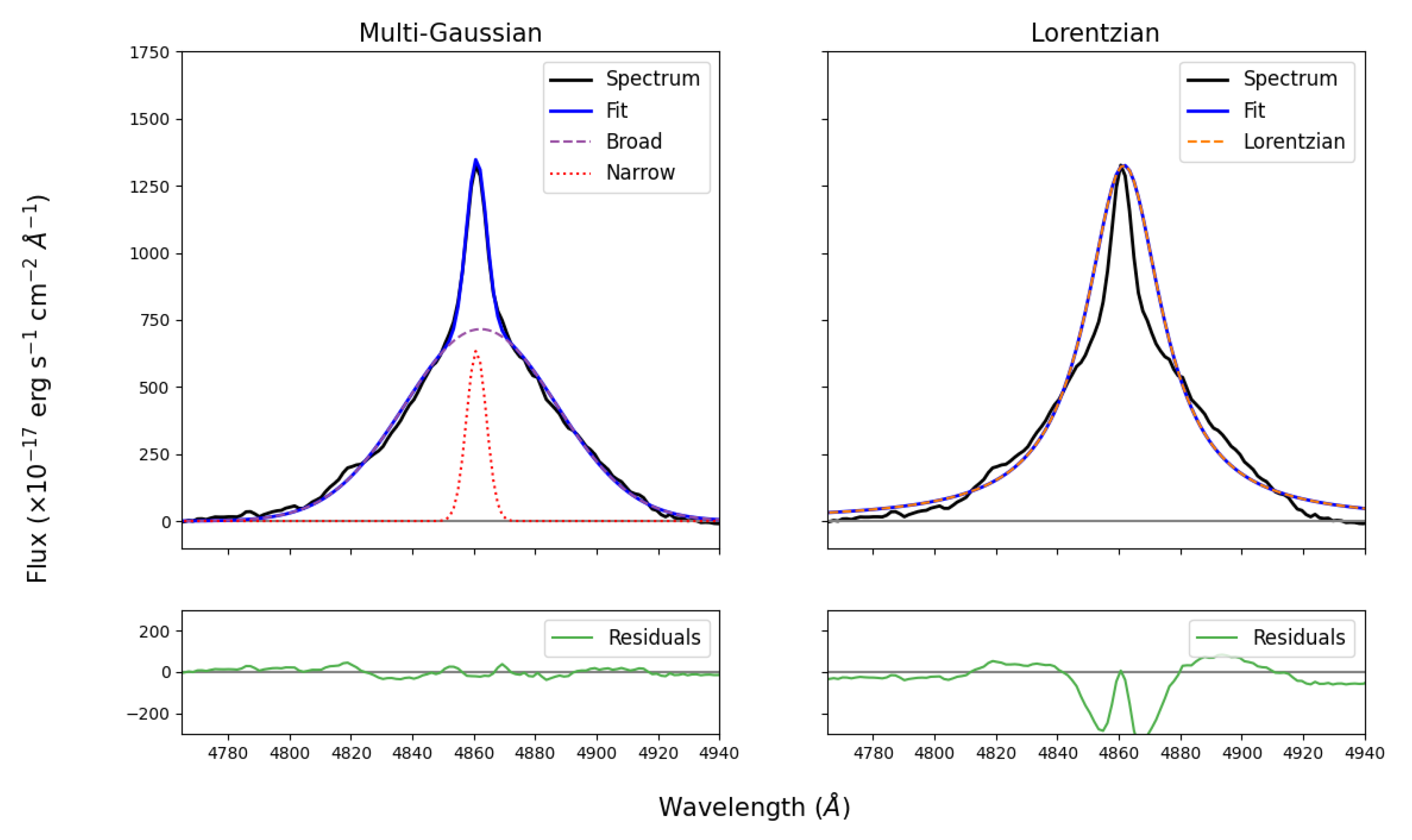
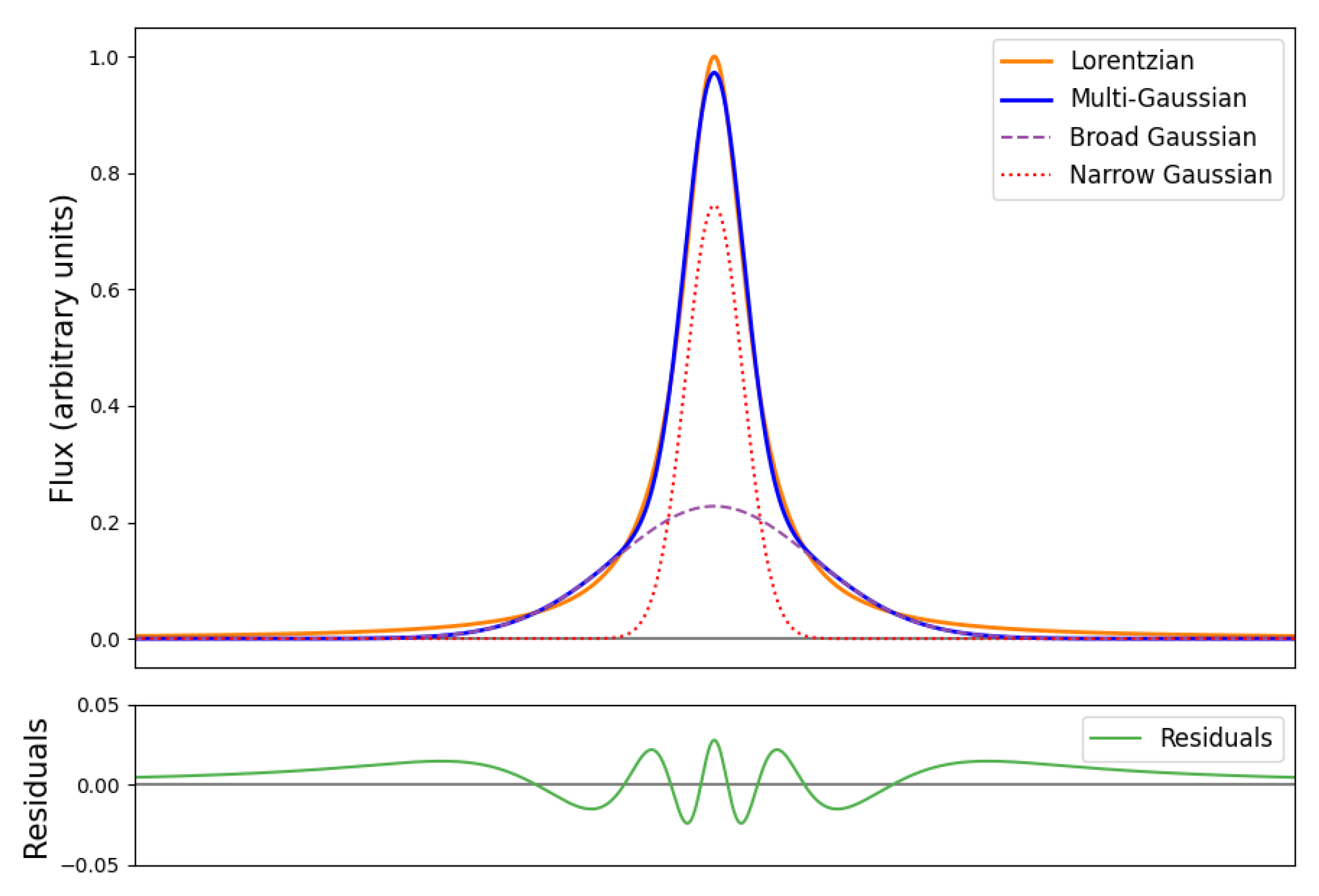

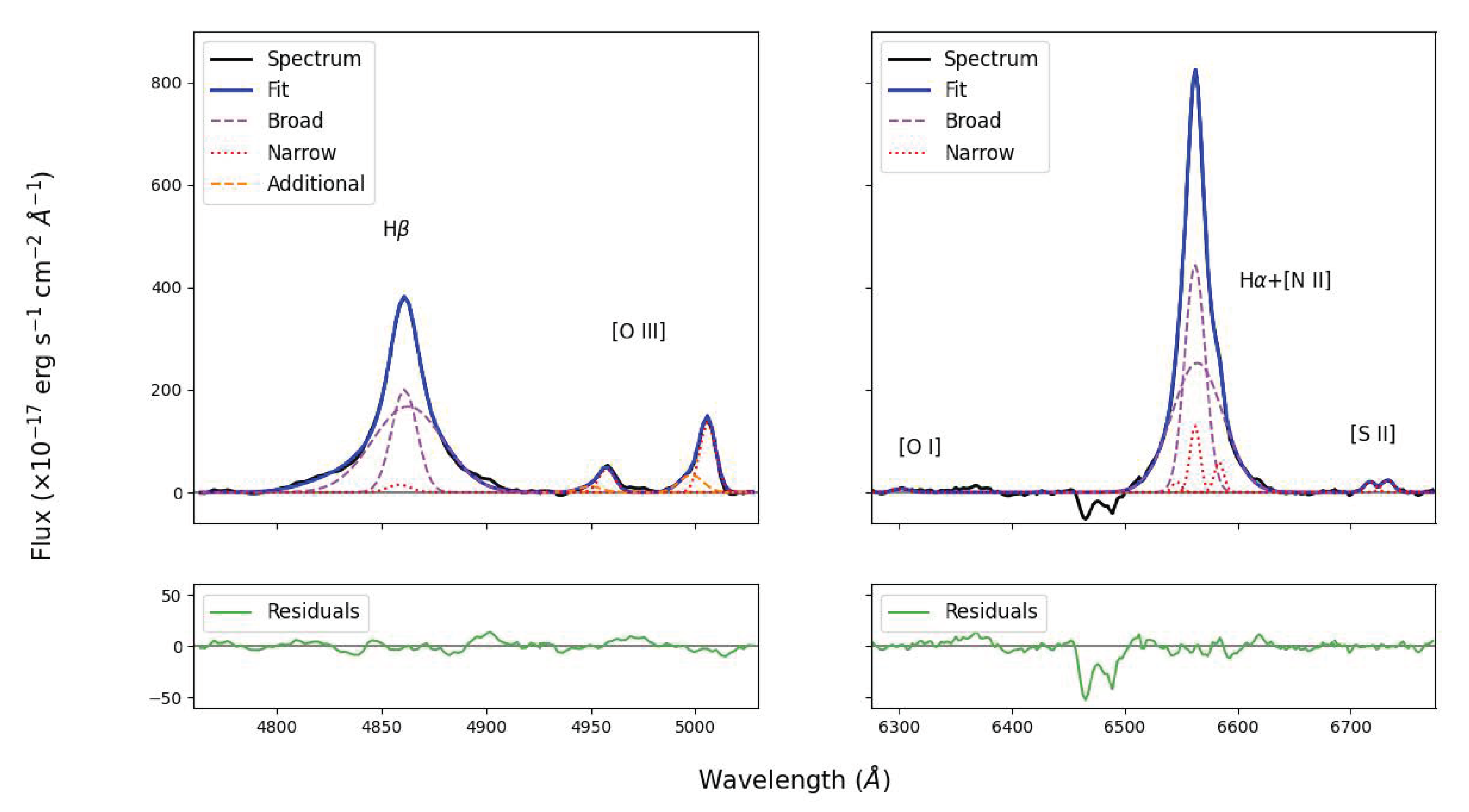
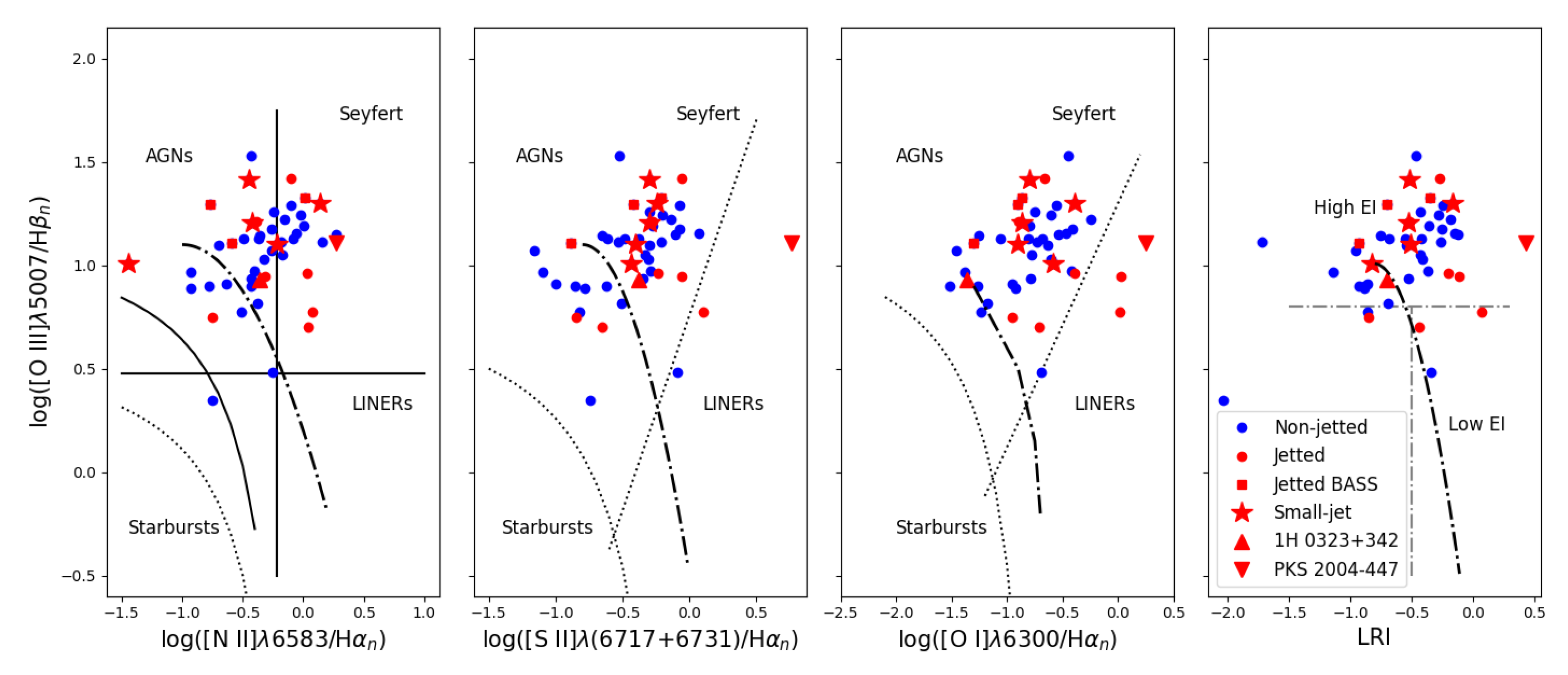
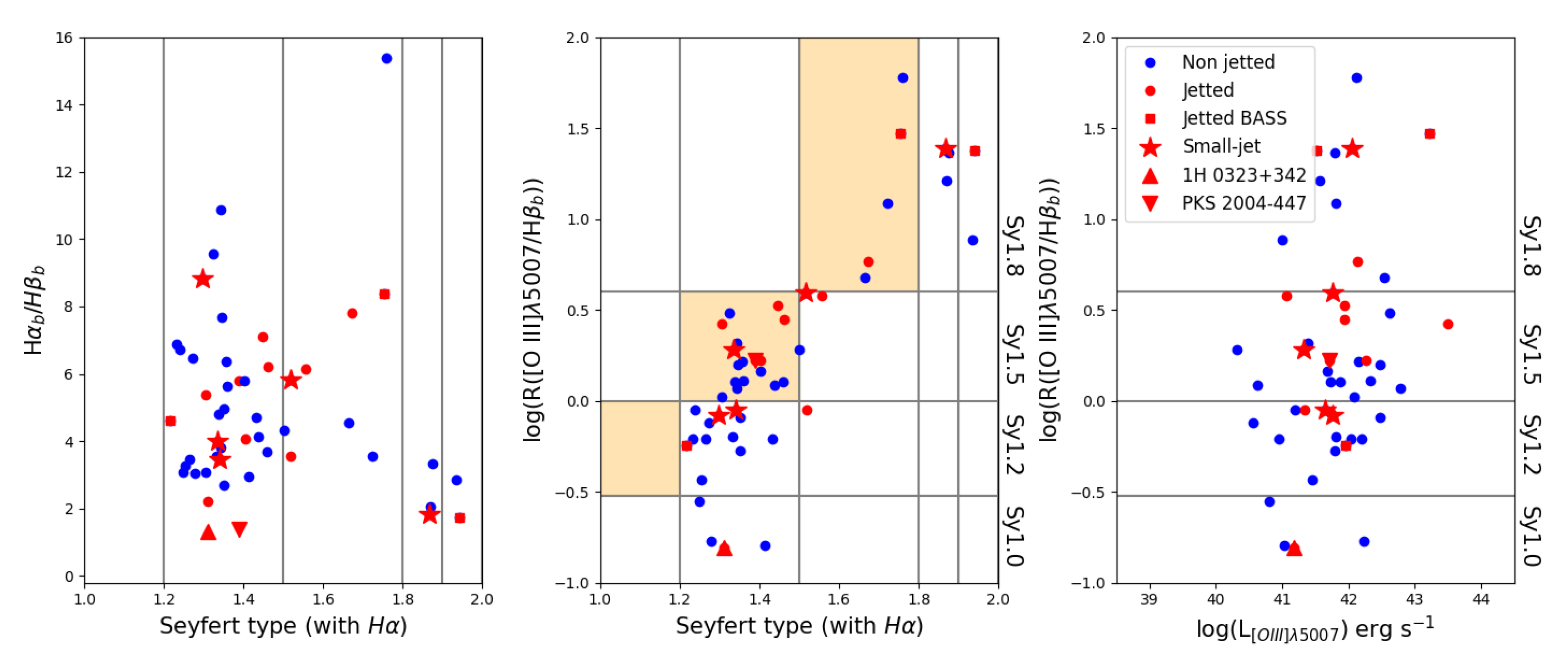
| Seyfert Type | Condition |
|---|---|
| Sy1 | |
| Sy1.2 | |
| Sy1.5 | |
| Sy1.8 | |
| Sy1.9 | Broad component only in H |
| 4FGL | BASS | ||
|---|---|---|---|
| Number | Condition | Number | Condition |
| 2982 | Total number of sources from 4FGL (with 1H 0323+342 and PKS 2004-447) | 1210 | Total number of sources from BASS |
| 80 | CL + MIS + SEY + NLS1 + AMB | 638 | With the optical spectra |
| 52 | With at least some spectral features visible (H/H/[O III]) | 334 | With at least some spectral features visible (H/H/[O III]) |
| 15 | Complete spectra (from H to [S II]) | 121 | Complete spectra (from H to [S II]) |
| 11 | No Sy1.9, [O I]6300 and/or [S II]6717, 6731 significant | 38 | No Sy1.9, [O I]6300 and/or [S II]6717, 6731 significant |
Disclaimer/Publisher’s Note: The statements, opinions and data contained in all publications are solely those of the individual author(s) and contributor(s) and not of MDPI and/or the editor(s). MDPI and/or the editor(s) disclaim responsibility for any injury to people or property resulting from any ideas, methods, instructions or products referred to in the content. |
© 2023 by the authors. Licensee MDPI, Basel, Switzerland. This article is an open access article distributed under the terms and conditions of the Creative Commons Attribution (CC BY) license (https://creativecommons.org/licenses/by/4.0/).
Share and Cite
Dalla Barba, B.; Berton, M.; Foschini, L.; La Mura, G.; Vietri, A.; Ciroi, S. Optical Properties of Two Complementary Samples of Intermediate Seyfert Galaxies. Physics 2023, 5, 1061-1080. https://doi.org/10.3390/physics5040069
Dalla Barba B, Berton M, Foschini L, La Mura G, Vietri A, Ciroi S. Optical Properties of Two Complementary Samples of Intermediate Seyfert Galaxies. Physics. 2023; 5(4):1061-1080. https://doi.org/10.3390/physics5040069
Chicago/Turabian StyleDalla Barba, Benedetta, Marco Berton, Luigi Foschini, Giovanni La Mura, Amelia Vietri, and Stefano Ciroi. 2023. "Optical Properties of Two Complementary Samples of Intermediate Seyfert Galaxies" Physics 5, no. 4: 1061-1080. https://doi.org/10.3390/physics5040069
APA StyleDalla Barba, B., Berton, M., Foschini, L., La Mura, G., Vietri, A., & Ciroi, S. (2023). Optical Properties of Two Complementary Samples of Intermediate Seyfert Galaxies. Physics, 5(4), 1061-1080. https://doi.org/10.3390/physics5040069







